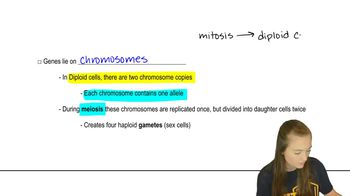In an 1889 book titled Natural Inheritance (Macmillan, New York), Francis Galton, who investigated the inheritance of measurable (quantitative) traits, formulated a law of 'ancestral inheritance.' The law stated that individuals inherit approximately one-half of their genetic traits from each parent, about one-quarter of the traits from each grandparent, one-eighth from each great grandparent, and so on. In light of the chromosome theory of heredity, argue either in favor of Galton's law or against it.
Table of contents
- 1. Introduction to Genetics51m
- 2. Mendel's Laws of Inheritance3h 37m
- 3. Extensions to Mendelian Inheritance2h 41m
- 4. Genetic Mapping and Linkage2h 28m
- 5. Genetics of Bacteria and Viruses1h 21m
- 6. Chromosomal Variation1h 48m
- 7. DNA and Chromosome Structure56m
- 8. DNA Replication1h 10m
- 9. Mitosis and Meiosis1h 34m
- 10. Transcription1h 0m
- 11. Translation58m
- 12. Gene Regulation in Prokaryotes1h 19m
- 13. Gene Regulation in Eukaryotes44m
- 14. Genetic Control of Development44m
- 15. Genomes and Genomics1h 50m
- 16. Transposable Elements47m
- 17. Mutation, Repair, and Recombination1h 6m
- 18. Molecular Genetic Tools19m
- 19. Cancer Genetics29m
- 20. Quantitative Genetics1h 26m
- 21. Population Genetics50m
- 22. Evolutionary Genetics29m
2. Mendel's Laws of Inheritance
Probability and Genetics
Problem 30b
Textbook Question
Albinism, caused by a mutational disruption in melanin (skin pigment) production, has been observed in many species, including humans. In 1991, and again recently in 2017, the only documented observations of an albino humpback whale (named 'Migaloo') were observed near New South Wales. Recently, Polanowski and coworkers (Polanowski, A., S. Robinson-Laverick, and D. Paton. (2012). Journal of Heredity 103:130–133) studied the genetics of humpback whales from the east coast of Australia, including Migaloo. Assuming that Migaloo's albinism is caused by a rare dominant gene, what would be the likelihood of the establishment of a natural robust subpopulation of albino white humpback whales in this population?
 Verified step by step guidance
Verified step by step guidance1
Understand the genetic basis of the problem: Albinism in this case is caused by a rare dominant gene. This means that an individual only needs one copy of the dominant allele (A) to express the albino phenotype. The normal phenotype is recessive (aa).
Consider the population genetics context: Since the albino trait is rare, the frequency of the dominant allele (A) in the population is likely to be very low. Use the Hardy-Weinberg principle to model allele frequencies and predict genotype frequencies in the population.
Set up the Hardy-Weinberg equilibrium equations: Let p represent the frequency of the dominant allele (A) and q represent the frequency of the recessive allele (a). The sum of allele frequencies is p + q = 1. The genotype frequencies are given by p² (homozygous dominant, AA), 2pq (heterozygous, Aa), and q² (homozygous recessive, aa).
Analyze the reproductive potential of albino individuals: Since albinism is dominant, both AA and Aa individuals will express the albino phenotype. However, the likelihood of establishing a robust subpopulation depends on factors such as the fitness of albino individuals, their ability to find mates, and the inheritance patterns of their offspring.
Evaluate the likelihood of a robust subpopulation: Given the rarity of the dominant allele (A), the initial frequency of albino individuals (AA and Aa) will be very low. For a robust subpopulation to establish, the allele frequency (p) would need to increase over generations, which could occur through mechanisms such as non-random mating, genetic drift, or selection favoring albino individuals. Assess these factors to determine the feasibility of a robust subpopulation.
 Verified video answer for a similar problem:
Verified video answer for a similar problem:This video solution was recommended by our tutors as helpful for the problem above
Video duration:
2mPlay a video:
Was this helpful?
Key Concepts
Here are the essential concepts you must grasp in order to answer the question correctly.
Genetic Inheritance
Genetic inheritance refers to the process by which traits and characteristics are passed from parents to offspring through genes. In the case of albinism, if it is caused by a dominant gene, only one copy of this gene is needed for the trait to be expressed. Understanding the principles of dominant and recessive alleles is crucial for predicting the likelihood of offspring inheriting specific traits.
Recommended video:
Guided course

Diploid Genetics
Population Genetics
Population genetics is the study of genetic variation within populations and how these variations change over time due to factors like natural selection, genetic drift, and gene flow. In assessing the likelihood of a robust subpopulation of albino humpback whales, it is important to consider the genetic diversity, reproductive rates, and survival of individuals with the albino trait within the larger population.
Recommended video:
Guided course

Descriptive Genetics
Mutation and Phenotypic Expression
Mutation refers to changes in the DNA sequence that can lead to variations in traits, such as albinism, which results from a disruption in melanin production. The phenotypic expression of a mutation can be influenced by environmental factors and interactions with other genes. Understanding how mutations affect phenotype is essential for evaluating the potential for a stable subpopulation of albino whales, as it impacts their survival and reproductive success.
Recommended video:
Guided course

Mutations and Phenotypes
Related Videos
Related Practice
Textbook Question
412
views


